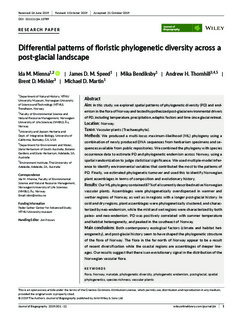| dc.contributor.author | Mienna, Ida M. | |
| dc.contributor.author | Speed, James David Mervyn | |
| dc.contributor.author | Bendiksby, Mika | |
| dc.contributor.author | Thornhill, Andrew H. | |
| dc.contributor.author | Mishler, Brent D | |
| dc.contributor.author | Martin, Michael David | |
| dc.date.accessioned | 2020-01-15T08:50:24Z | |
| dc.date.available | 2020-01-15T08:50:24Z | |
| dc.date.created | 2019-12-26T19:15:15Z | |
| dc.date.issued | 2019 | |
| dc.identifier.citation | Journal of Biogeography. 2019, 1-12. | nb_NO |
| dc.identifier.issn | 0305-0270 | |
| dc.identifier.uri | http://hdl.handle.net/11250/2636325 | |
| dc.description.abstract | Aim: In this study, we explored spatial patterns of phylogenetic diversity (PD) and end-emism in the flora of Norway and tested hypothesized post-glacial environmental drivers of PD, including temperature, precipitation, edaphic factors and time since glacial retreat.Location: Norway.Taxon: Vascular plants (Trachaeophyta).Methods: We produced a multi-locus maximum-likelihood (ML) phylogeny using a combination of newly produced DNA sequences from herbarium specimens and se-quences available from public repositories. We combined the phylogeny with species occurrence data to estimate PD and phylogenetic endemism across Norway, using a spatial randomization to judge statistical significance. We used multiple-model infer-ence to identify environmental variables that contributed the most to the patterns of PD. Finally, we estimated phylogenetic turnover and used this to identify Norwegian plant assemblages in terms of composition and evolutionary history.Results: Our ML phylogeny contained 87% of all currently described native Norwegian vascular plants. Assemblages were phylogenetically overdispersed in warmer and wetter regions of Norway, as well as in regions with a longer post-glacial history. In cold and dry regions, plant assemblages were phylogenetically clustered, and charac-terized by neo-endemism, while the mild and wet regions were characterized by both paleo- and neo-endemism. PD was positively correlated with summer temperature and habitat heterogeneity, and peaked in the southeast of Norway.Main conclusions: Both contemporary ecological factors (climate and habitat het-erogeneity), and post-glacial history seem to have shaped the phylogenetic structure of the flora of Norway. The flora in the far north of Norway appear to be a result of recent diversification while the coastal regions are assemblages of deeper line-ages. Our results suggest that there is an evolutionary signal in the distribution of the Norwegian vascular flora. | nb_NO |
| dc.language.iso | eng | nb_NO |
| dc.publisher | Wiley | nb_NO |
| dc.rights | Navngivelse 4.0 Internasjonal | * |
| dc.rights.uri | http://creativecommons.org/licenses/by/4.0/deed.no | * |
| dc.title | Differential patterns of floristic phylogenetic diversity across a post-glacial landscape | nb_NO |
| dc.type | Journal article | nb_NO |
| dc.type | Peer reviewed | nb_NO |
| dc.description.version | publishedVersion | nb_NO |
| dc.source.pagenumber | 1-12 | nb_NO |
| dc.source.journal | Journal of Biogeography | nb_NO |
| dc.identifier.doi | 10.1111/jbi.13789 | |
| dc.identifier.cristin | 1763906 | |
| dc.description.localcode | © 2019 The Authors. Journal of Biogeography published by John Wiley & Sons Ltd. This is an open access article under the terms of the Creative Commons Attribution License, which permits use, distribution and reproduction in any medium, provided the original work is properly cited. | nb_NO |
| cristin.unitcode | 194,31,10,0 | |
| cristin.unitname | Institutt for naturhistorie | |
| cristin.ispublished | true | |
| cristin.fulltext | postprint | |
| cristin.qualitycode | 2 | |

